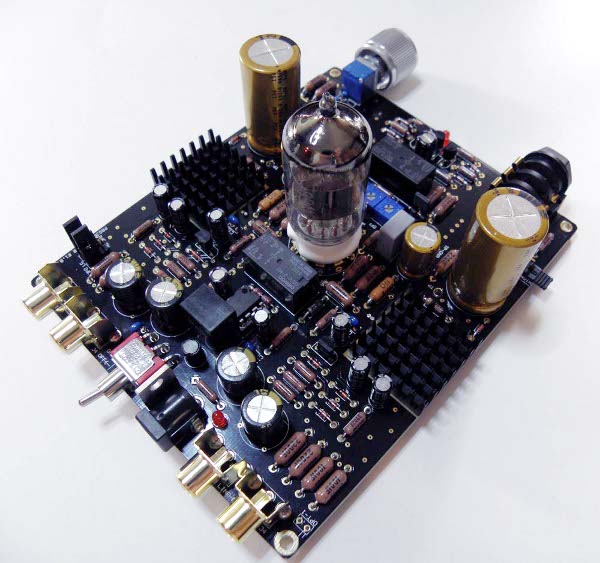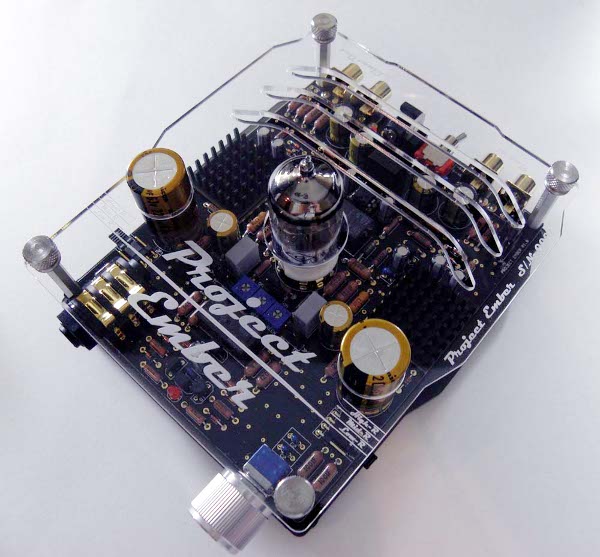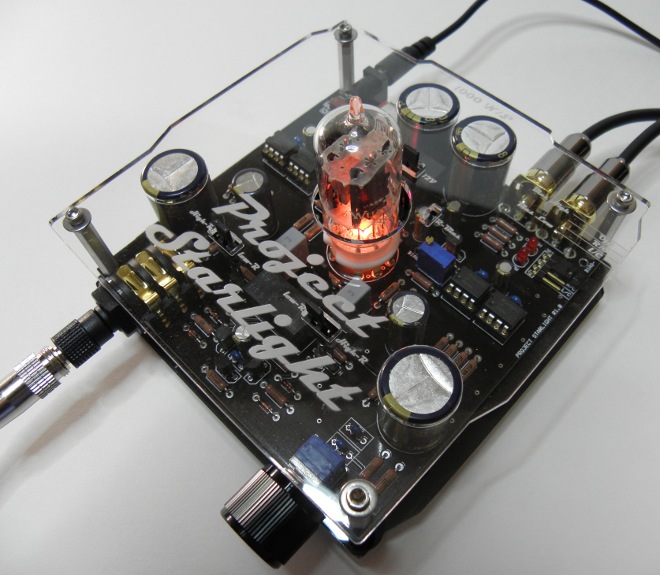solderdude
Administrator
measureutternutter
Posts: 4,886
|
Post by solderdude on May 18, 2013 5:38:25 GMT
After some delays Project Ember is finally available. It took a bit longer than originally planned due to the little time available and because we continuously tried to improve the prototype and wanted to add or change functionality.   A few weeks before it's smaller cousin Starlight was launched. Originally intended to be much lower in price but because it is pointless to come up with another clone we were constantly changing/improving things.  More info on Jeremy's website www.garage1217.com/This thread is intended for questions and technical support. |
|
Rabbit
Administrator
Posts: 7,091
|
Post by Rabbit on May 18, 2013 17:06:38 GMT
we continuously tried to improve the prototype and wanted to add or change functionality.
What did you feel needed improving, Frans? I do agree, if it costs a bit more, it's better to do it than leave it as is. People will only go and mod them in any case if they go out under par or whatever.
It's obviously not generating the same kind of heat, I guess, which is a really good thing in the long run. It also has some configuration possibilities on there too which is really nice.
The only thing I'd change is the on/off switch if there were room. It would be easier on the front since if you put it into a unit, you have to grapple around the back or switch off at the mains.
The Aune does the same, but I have a switch on the power supply to turn it on and off. (Pinkie)
|
|
solderdude
Administrator
measureutternutter
Posts: 4,886
|
Post by solderdude on May 18, 2013 21:25:33 GMT
Over time we changed a lot of things along the way and I had to build and test some of the circuits before handing them over to Jeremy. Most of the experiments were done on the OPA-88 amp I made a while back.  this kept us from 'finalising' the design. Over time the following steps were made before we thought it could be called a product. The first design was more or less a Horizon with the output stage changed to the buffer type output that is still in place. (see OPA-88 amp shown above) Subsequently I added auto-bias. Changed that circuit slightly in a few small iterations to make it perform better. At this point the project Ember was more or less ready to launch we figured so hints in that direction were vented. Next I thought it would be handy if the heater was selected automatically so a jumper was no longer needed and no errors can be made by users any more. It would also be easier to use tubes with no markings on them as the voltage didn't matter. After that I thought it would be easier if the output R selector was simply done with 1 jumper in 3 positions instead of 2 jumpers that work intuitively 'strange' so meant a redesign. Later I simplified and improved the auto heater select circuit Changed the RCA output (pre-amp) voltage so it could be used better as a preamp. Changed the output device configuration for better performance and used other devices but were hard to get so changed it back. Added a gain select jumper as some found the gain to be on the side of too high (with a little travel on the volpot a too loud volume) Changed the output configuration to something similar as we did on the Starlight and hoped to pump out 5W-6W on 32 Ohm this way. a proto PCB was built. Had some issues with the protection relay action which didn't switch as intended so made a small change. The proto had some temperature issues and doubling the output power was not working as we wanted and were plagued by small oscillations. This meant we fell back on the current output configuration and changed it a bit to deal with temperature issues when using normal 8-pin DIP output devices. In real life situations this worked perfectly and the temperature stayed low. On a test bench it became too hot. I added thermal protection (which had to be tested thoroughly). It was decided later on SMD devices were going to be used but meant these devices had to be pre-soldered. Another change in the layout.. The layout was a constant re-arranging and optimising anyway (as it is with any design) Indicator LED's were added and the output stage configuration was changed slightly again. We still had some things we wanted to change but decided the amp is functioning as we wanted it too so it was finally launched. The switch to the front was another idea that I wanted for a long time but because the DC input is at the back this meant long wires running up and down on the PCB so for optimizing power wire routing decided to keep those wires as short as possible. Now it is up and running and performing even better than my 'proto' OPA-88 amplifier due to optimised PCB design. We are planning to offer a linear power supply for the amplifier range (regulated 24V and 48V DC linear power supplies). |
|
Rabbit
Administrator
Posts: 7,091
|
Post by Rabbit on May 19, 2013 9:31:11 GMT
So much better than flinging stuff out there ready for modding, Frans. ie - a FINAL product. My guess is that's where it will do better than the many other Chinese designs that are really more reminiscent of a prototype. ie; they seem to work in the short term but later on, problems (especially heat) rear their ugly heads.
There are some really great ideas there, Frans. Auto biasing for tubes takes the concern away and constant measuring and adjusting. Why on earth that's not a common procedure for all valves, I don't know!!
You're going for BIG power out to headphone so it will provide lots of headroom and I guess the power supply will become increasingly more important taking that into mind as well. Perhaps even a switch on that would get by the back power switch? I must admit, the Pinkie with its switch does make the Aune T1 a lot more convenient to tuck away into a unit.
I'm not convinced having a vol pot on the top rather than the front though. A bigger circumference on the vol pot sometimes helps with the sensitivity. I changed the knob on my Neco and that has made it much less prone to sudden increases in volume.
I guess the heat build up is low too? In any case, with and open frame, there's not too much chance of heat building up.
|
|
solderdude
Administrator
measureutternutter
Posts: 4,886
|
Post by solderdude on May 19, 2013 16:20:01 GMT
The only thing that gets warm (not hot) is the tube.
The output stage (actually the rest of the entire amp) will be room temp.
Perhaps when driving the likes of HE6 e.t.c. it might get warm when driving it loud.
The earlier prototype did not have any cooling and the output devices would get hot in this case.
In the production model the top and bottom layer of the PCB act as big heatsinks which would already be more than enough but Jeremy liked the looks and better cooling action of the small heatsinks on top.
These low temperatures will certainly help in longevity.
One of the main reasons (there were others as well) for it's existence.
|
|
proid
quite active
Posts: 113
|
Post by proid on May 26, 2013 10:16:10 GMT
The Ember look great, Frans. I wonder how the Ember can manage to ouput nearly 2W when in the datasheet, OPA551 output current is only 200ma? Sorry for my silly question, i only know little about amp designing  . |
|
solderdude
Administrator
measureutternutter
Posts: 4,886
|
Post by solderdude on May 26, 2013 13:18:55 GMT
The question is not silly.
Even though the OPA551 is rated for 200mA continuous it can easily deliver 300mA peak currents.
Music is all about dynamics so 300mA is max.
BUT this is a peak value and to calculate power you need the RMS value.
300mA / SQRT(2) = 210mA RMS.
It does need sufficient heatsinking though and is the reason we are using the DDPAK version instead of the DIP-8.
To calculate power P= U x I
Since the U = I x R we can also say P = I x I x R
In 32 Ohm this means: 0.21A x 0.21A x 32 = 1.44W
In 50 Ohm this means 0.21A x 0.21A x 50 = 2.25W
of course at a certain point the output voltage will become limiting factor.
so in a 120 Ohm based on the I x I x R we would be having 5.4W output power.
Alas the maximum output voltage is limited to 15V and because P = (U x U)/R this means (15 x 15)/120 = 1.9W
Because the output stage has an isolator resistor added that as a bonus lowers the dissipation when low impedance HP's are used power is slightly lower so just under 2W.
|
|
Rabbit
Administrator
Posts: 7,091
|
Post by Rabbit on May 27, 2013 16:36:58 GMT
 That's a lot of power for a headphone. To think, not too far back, I considered 0.5W from the Xcan a lot!!!
|
|
Rabbit
Administrator
Posts: 7,091
|
Post by Rabbit on May 28, 2013 12:58:48 GMT
It took blood sweat and tears but worth every drop! Frans, you did an amazing job on both - Thank you. What I really like about all of these amps is how they are designed to get as good a sound as possible out of them for the money. They provide what headphone people want, in that there is some room for us to be able to tweak the configuration so that there's a better match with our headphones. Self-adjusting the bias. Longevity will be even better with less heat. Also, with plenty of life there it will be able to provide lots of headroom which is really important. My Horizon also provides loads of headroom too and is a little beauty of an amp. Jeremy has also done a great job, getting these things to the market and now providing us all with different options; either as a kit or pre-built. |
|
|
|
Post by dragnet32 on May 30, 2013 18:48:09 GMT
New member here:
I was planning on buying a Horizon to use for higher impedance headphones. (I have a Senn HD650). For lower impedance like Hifiman HE-300 I was going to use portable headphone amps (have Arrow 4G)....Now with the Ember I am a bit confused, since it can be used with wide range of phones. For HD 650, if sound quality is my main concern, is the Class A Horizon the way to go or the Ember with its solid state output? Thanks for info. Dragnet. Lacey, Washington USA.
|
|
Rabbit
Administrator
Posts: 7,091
|
Post by Rabbit on May 30, 2013 19:07:54 GMT
Hi Lacey. Welcome to DIYAH.
You may well find Horizons selling second hand because some may want to go for the new Ember.
I currently have a Horizon and it drives the HD650 with absolute ease. It's a good amp with plenty of power as well. I'm currently listening via the Horizon into Beyer DT990. (250 ohms) The amp is at 8 'o clock and has plenty more volume to go - and it's not dead as you raise it. It keeps going to ridiculous levels.
I guess what I'm saying is that you may get a good deal on a Horizon if you want to save the pennies.
The Ember looks really nice as well though and it certainly has some power available for plenty of headroom.
|
|
solderdude
Administrator
measureutternutter
Posts: 4,886
|
Post by solderdude on May 30, 2013 20:57:40 GMT
If you are ONLY going to use the HD650 the Horizon and Ember are 'similar' in sound signature.
They are also about the same in output power for impedances above 120 Ohm.
This is because in basics these 2 amplifiers are 'similar' as a 300 Ohm load is 'easy' for both designs.
The Ember is a lot more convenient when you want to roll tubes (regularly) as it adjusts itself.
When you do not plan to roll tubes this doesn't have to be a consideration.
The Sunrise-II is more powerful than Horizon in low impedance headphones but not as powerful as Ember.
The Ember output stage is not single ended class-A (Horizon and Sunrise are) but solid state and because of this with lower distortion (in any case much lower than that of the tube).
For 300 Ohm and up the harmonic distortion won't differ that much but the Ember has better performance on this aspect than the other 2 for low impedance headphones.
The Ember may be a bit 'dangerous' for the HE300 as this headphone is rated for 30mW (probably can handle 200mW)
The Ember will be able to provide close to 1.8W and could destroy these headphones when left unattended and on full power by accident.
Under normal use this won't be a problem but great care is to be taken.
Horizon will drive the HE300 fine by the way and will provide max 250mW.
So if you have HE300 and HD650 the Horizon is the safest bet.
If you plan to roll tubes and want to get a HE500 or harder to drive headphones in the future or like to play with lots of different tubes the Ember will be suited (with the warning for HE300)
|
|
Deleted
Deleted Member
Posts: 0
|
Post by Deleted on May 31, 2013 23:26:19 GMT
the burning question for me is
will this amp drive the he-6 to a decent level?
|
|
solderdude
Administrator
measureutternutter
Posts: 4,886
|
Post by solderdude on Jun 1, 2013 8:20:07 GMT
Hi Simon,
Welcome to the forum.
It should to decent levels but not to loud levels.
The Panda (with 0 Ohm) will most likely play it slightly louder.
at 50 Ohm and 1.5W input power an SPL of 108dB can be reached.
This is 8.6Vrms and would be similar to the output level an 18W into 4 Ohm power amplifier can deliver.
The Panda would be able to supply 10V which is 'only' 1.3dB louder (109.3dB) and is the equivalent of 25W/4 Ohm amplifier.
When considering classical music and the headroom for it's peaks this means average levels of 95-98 dB are possible.
Considering most people listen between 80 and 90dB you still have quite some headroom.
To reach 120dB (pain levels) you will need to pump 20W into the HE-6
For this you will need 32Vrms and to translate this into a power amplifier where it is connected to directly this means a 125W into 8 Ohm or 250 W into 4 Ohm amplifier is needed.
|
|
Deleted
Deleted Member
Posts: 0
|
Post by Deleted on Jun 1, 2013 19:57:54 GMT
Hi Simon, Welcome to the forum. It should to decent levels but not to loud levels. The Panda (with 0 Ohm) will most likely play it slightly louder. at 50 Ohm and 1.5W input power an SPL of 108dB can be reached. This is 8.6Vrms and would be similar to the output level an 18W into 4 Ohm power amplifier can deliver. The Panda would be able to supply 10V which is 'only' 1.3dB louder (109.3dB) and is the equivalent of 25W/4 Ohm amplifier. When considering classical music and the headroom for it's peaks this means average levels of 95-98 dB are possible. Considering most people listen between 80 and 90dB you still have quite some headroom. To reach 120dB (pain levels) you will need to pump 20W into the HE-6 For this you will need 32Vrms and to translate this into a power amplifier where it is connected to directly this means a 125W into 8 Ohm or 250 W into 4 Ohm amplifier is needed. Hi i do not listen at really loud levels anyway but i do want to be sure the quality is there at lower levels. will know more when i finally get to trial them (he-6, 500 and lcd2, that is) |
|